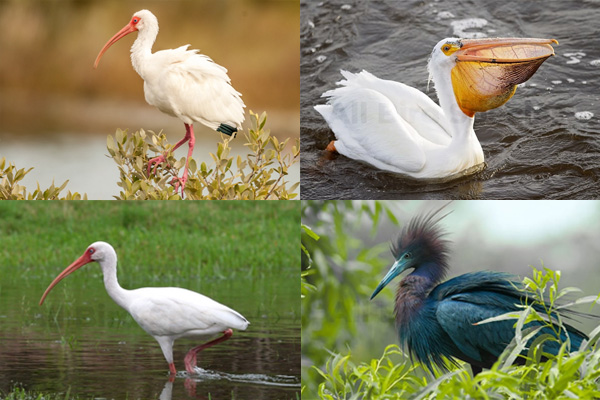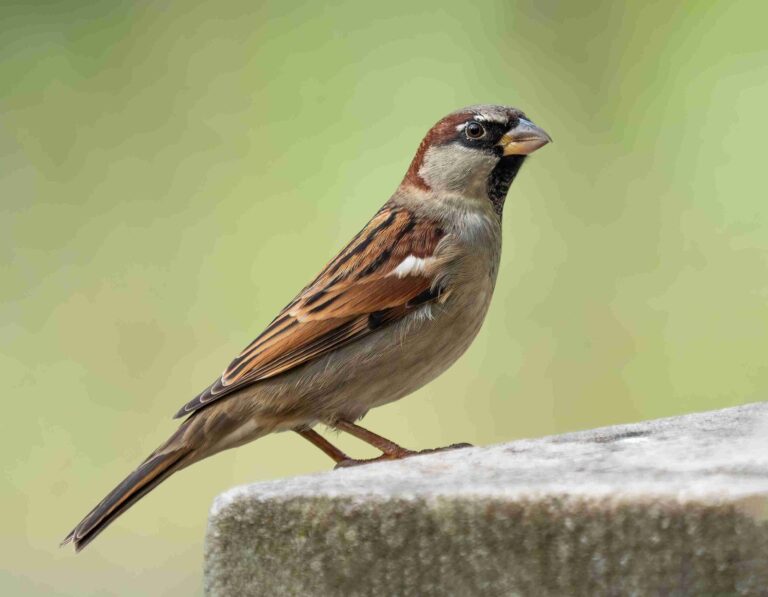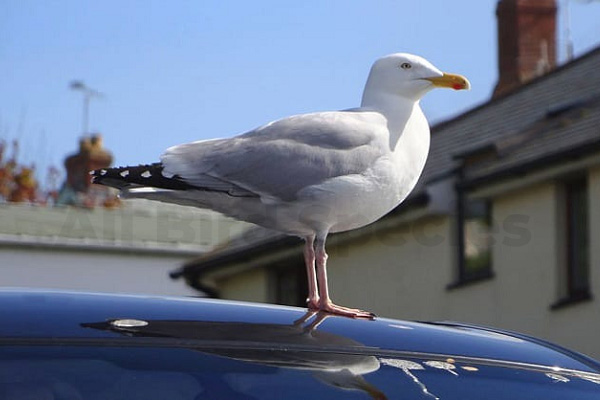Discover 10 White Birds in Florida (ID Guide With Photos)
White birds in Florida are captivating creatures found all over the state. I’ve researched their habits and habitats extensively. From majestic herons to striking egrets, they bring beauty to Florida’s wetlands. Want to know where to spot them? I’ll share the best locations and a few interesting facts. Whether you’re a birdwatcher or just curious, there’s so much to discover. Let’s dive into Florida’s stunning white bird population.
Introduction to Florida’s Avian Wonders
Florida is a treasure trove of avian diversity, with over 500 species of birds, making it a unique playground for birdwatching enthusiasts.
The state’s varied habitats are perfect for birds. You’ll find everything from coastal shores to freshwater wetlands. These places are ideal for both migratory and resident birds.
Each season brings new bird species. This makes Florida a hot spot for birdwatchers. You might see vibrant songbirds or majestic raptors during your adventures.
Birdwatching in Florida lets you see birds up close. You can watch their behaviors, see their beautiful plumage, and hear their calls. Exploring the state’s diverse ecosystems, you’ll find different habitats like mangroves, marshes, and forests. Each supports unique bird populations.
Florida’s natural beauty and bird species offer unforgettable experiences. Nature lovers and bird enthusiasts will find it captivating. So, get your binoculars ready and explore Florida’s bird world!
Why Florida is a Birdwatcher’s Paradise
Florida’s warm weather and many different places to explore make it perfect for birdwatching. You can find everything from beaches to the huge Everglades, which offer homes and food for many birds.
In the winter, birdwatching in Florida is even more exciting. Birds from the north come here because it’s warmer. You can see many different birds while enjoying the beautiful views. The Great Florida Birding and Wildlife Trail helps you find the best places to see birds.
Birdwatching is growing fast in the US. People love to find and learn about the colorful birds in Florida. You need binoculars, a guide for Florida birds, and a notebook to do well. A camera is great for taking pictures of the birds you see.
Camp Helen State Park, Florida, is home to over 180 bird species. Places like Grayton Beach State Park and Myakka River State Park are also great for seeing birds. You can see birds like the American bald eagle and the Florida scrub jay here. This makes Florida a top place for birdwatching in North America.
| Location | Notable Species | Best Time to Visit |
|---|---|---|
| Three Rivers State Park | American Bald Eagles | Winter |
| Lake Kissimmee State Park | Florida Scrub-Jay | Spring |
| Myakka River State Park | Roseate Spoonbills, Herons | Year-Round |
| Dr. Von D Mizell-Eula Johnson State Park | Brown Pelicans | Winter |
| Audubon’s Corkscrew Swamp Sanctuary | Wood Storks | Summer |
White Birds in Florida
Florida’s wetlands are home to many white bird species, each adding something special to the bird world. Birds like the Great Egret, Snowy Egret, Wood Stork, and White Ibis are favorites among birdwatchers.
Overview of Common Species
Florida’s landscapes are filled with white birds. Here are a few you might see:
- Great Egret: This bird has a huge wingspan of 52 to 57 inches and is a common sight in marshes and wetlands.
- Snowy Egret: It’s known for its beauty, with a wingspan of 39.4 inches.
- Wood Stork: It’s big, weighing about 96 ounces. Its wingspan is 65 inches.
- White Ibis: It’s about the size of a crow. It has bright red legs and bills. You’ll find it in wetlands.
Why White Birds Matter in the Ecosystem
White birds are key to Florida’s bird world. They help keep the environment balanced. They eat fish and small creatures, keeping numbers in check.
White Ibises search for food in shallow waters, looking for insects and crustaceans in the mud. The Great Egret and Snowy Egret also hunt fish, helping to maintain their numbers.
Together, these white birds make Florida’s wetlands healthy and diverse. They are important to the landscape.
1. Great Egret
- Scientific Name: Ardea alba
- Size: 85–102 cm (33–40 in)
- Weight: 700–1,500 g (1.5–3.3 lb)
- Lifespan: Up to 15 years in the wild
- Diet: Primarily fish, amphibians, and small invertebrates
The Great Egret (Ardea alba) stands out among Florida’s Wading Birds. It has stunning all-white feathers and is quite tall. It can grow up to 39 inches high and has a wingspan of over 51 inches.
You can find Great Egrets in many places in Florida. They like the mangrove-lined coasts and the big freshwater marshes of the Everglades.

This bird loves to eat fish, frogs, snakes, bugs, and small mammals. Its long legs and sharp beak help it hunt in shallow water. During breeding, it shows off its beautiful aigrettes in courtship rituals. It nests in colonies high up, between 10 and 40 feet.
Great Egrets almost disappeared in the 19th and 20th centuries because of their beautiful feathers. Thanks to the National Audubon Society and the Migratory Bird Treaty Act of 1918, they’re back. Now, they’re not considered endangered anymore.
It’s important to keep a safe distance when watching these birds, especially when they’re breeding. Florida’s wetlands are great places to see Great Egrets. Everglades National Park and Merritt Island National Wildlife Refuge are especially good spots. Watching a Great Egret move through its home is truly magical.
2. Snowy Egret
- Scientific Name: Egretta thula
- Size: 60–66 cm (24–26 in)
- Weight: 300–500 g (10.6–17.6 oz)
- Lifespan: Up to 10 years in the wild
- Diet: Primarily small fish, crustaceans, and insects
The Snowy Egret White Birds of Florida is a graceful bird in the wading family. It has white feathers and yellow feet. Birdwatchers in Florida love seeing them in wetlands.
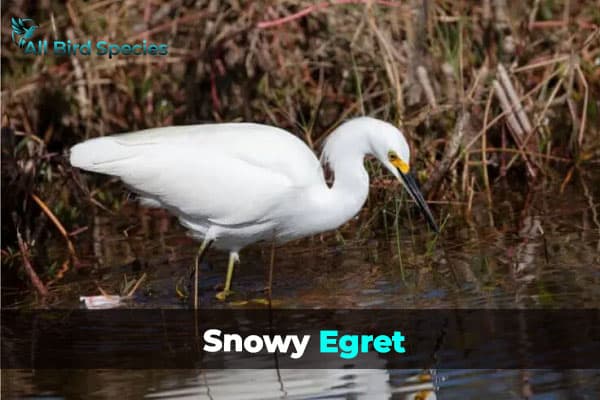
Identifying Key Features
Look at a Snowy Egret, and you’ll see its elegance. It has:
- Fluffy white feathers create a striking silhouette.
- Long, slender black legs accentuate its grace.
- Bright yellow feet are used for stirring mud in search of prey.
- During mating season, the feet shift from greenish-yellow to a vibrant orange-yellow.
- Facial skin transitions from yellow to reddish, adding to its allure.
Habitats and Behavior
Snowy Egrets live in wetlands, marshes, and shorelines, which are perfect for them to find food and nest. They also hunt small fish, crustaceans, and insects with skill.
They hunt in shallow waters, moving gracefully. Plus, They stir the water with their feet to catch prey. They can live with other birds and even mate with different egrets, creating hybrids.
| Feature | Snowy Egret | Great Egret | Cattle Egret |
|---|---|---|---|
| Color of Plumage | White | White | White with a hint of buff |
| Foot Color During Breeding | Orange-yellow | N/A | Yellow |
| Common Habitat | Wetlands, marshes, shorelines | Wetlands, ponds, lakes | Grasslands, farms, wetlands |
| Feeding Behavior | Stirs mud to find prey | Catches prey with a quick strike | Forages around livestock |
3. Roseate Spoonbill
- Scientific Name: Platalea ajaja
- Size: 81–86 cm (32–34 in)
- Weight: 2–3.6 kg (4.4–7.9 lb)
- Lifespan: Up to 30 years in the wild
- Diet: Primarily small fish, crustaceans
The Roseate Sponbill is a standout among Florida’s wading birds. It is bright pink and has unique features. Watching these birds in Florida’s wetlands is a thrilling experience, especially when they nest.

Knowing how to spot them is key for bird lovers. It helps us appreciate these amazing birds.
Distinguishing Marks and Colors
The Roseate Spoonbill’s White Birds in Florida’s bright pink color is eye-catching. Their color changes based on what they eat, making them even more beautiful.
They have no feathers on their faces. This gives them a special look. Their red eyes and spoon-shaped bill help them find food in shallow water.
They nest in trees over water to stay safe from predators. This is good for their young and helps conservation efforts. In mid-February, you can see them showing off in Orlando Wetlands.
- Long legs suitable for wading through shallow waters
- The absence of feathers on the face contributes to a unique appearance
- Size that is larger compared to many other wading birds
Roseate Spoonbills work hard to build nests. They use fresh twigs for this. Camera tech lets us see their mating season in amazing detail.
These birds have come a long way. Once few in number, now they’re thriving thanks to protection. They’re a symbol of Florida’s wetlands.
4. Wood Stork
- Scientific Name: Mycteria americana
- Size: 81–102 cm (32–40 in)
- Weight: 2.3–3.6 kg (5.1–7.9 lb)
- Lifespan: Up to 20 years in the wild
- Diet: Primarily fish, but also amphibians and crustaceans, foraging in shallow waters
The Wood Stork is North America’s only true stork. It’s known for its long legs and neck. This bird lives in wetlands, where it hunts for fish.
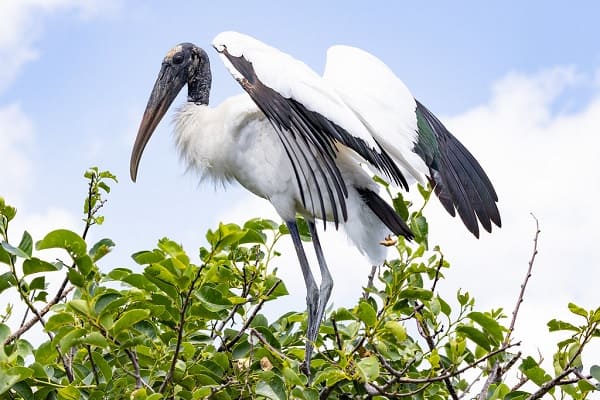
It uses its beak to feel for movement in murky waters. This shows its unique hunting skills.
Once, the Wood Stork was endangered due to habitat loss. Places like the Florida Everglades were hit hard. But thanks to conservation, its numbers have grown.
Now, it’s considered threatened, which shows that bird conservation is working. It’s protecting the habitats these storks need.
Wood Storks nest in tall cypress trees. Their nests are made of sticks and green twigs. Up to 25 nests can be in one tree.
Each nest has three to five cream-colored eggs. Both parents incubate the eggs for 27 to 32 days. After breeding, they can be found in states like Alabama and Mississippi.
Protecting the wetland ecosystem is important. Development in Florida threatens their homes. We need to keep supporting bird conservation to save the Woodstork.
5. Cattle Egret
- Scientific Name: Bubulcus ibis
- Size: 46–56 cm (18–22 in)
- Weight: 250–500 g (8.8–17.6 oz)
- Lifespan: Up to 15 years in the wild
- Diet: Primarily insects, small mammals
The Cattle Egret White Birds of Florida is a fascinating bird known for its love of company. They live in big groups and show interesting ways of interacting. Their nesting together is key to their social life and hunting together.
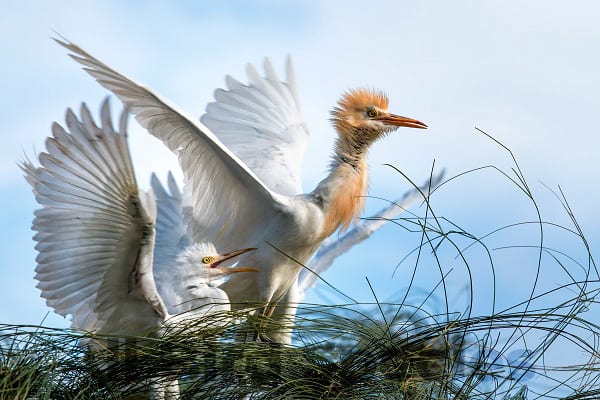
Understanding their Social Behavior
Cattle Egrets nest in huge groups, which helps them survive. This helps them feed together and stay safe from predators. They hang out near animals, eating bugs that the animals stir up.
This relationship shows how nature works together. The egrets and animals help each other out. By nesting together, egrets also live with other birds, making a safe and lively community.
Watching Cattle Egrets shows us how they work together. It’s a beautiful sight in Florida’s wetlands.
6. Little Blue Heron
- Scientific Name: Egretta caerulea
- Size: 60–66 cm (24–26 in)
- Weight: 300–600 g (10.6–21.2 oz)
- Lifespan: Up to 15 years in the wild
- Diet: Primarily fish, amphibians, and small invertebrates
The Little Blue Heron White Birds of Florida are special among Blue Heron species. It starts as a pure white juvenile. As it grows, its feathers turn to shades of blue like slate and cobalt. It also has a deep reddish-purple on its head and neck.
This bird’s look often surprises birdwatchers. Knowing how to spot the Little Blue Heron is key for Florida birdwatching.
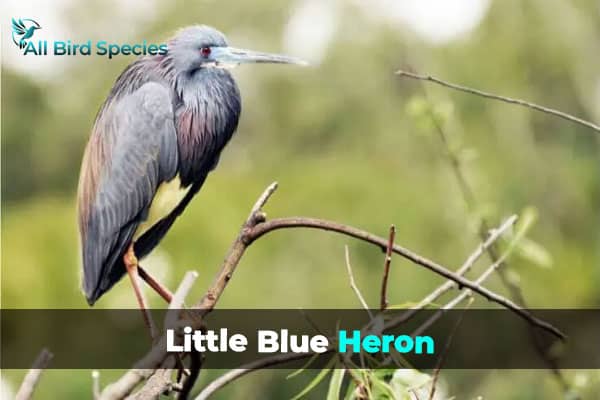
Found mainly in the Americas, the Little Blue Heron breeds in the Southeastern United States. It migrates to southern states, Mexico, and Central and South America. In Florida, it lives along the Gulf Coast, near quiet waters like ponds and swamps.
During breeding, females lay 3 to 4 pale bluish-green eggs. The nests are in shrubs or small trees. The downy white hatchlings stay in the nest for 35-50 days, getting food and protection from their parents.
To improve your birdwatching, follow these tips for spotting the Little Blue Heron:
- Visit wetland areas during early morning or late afternoon for optimal activity.
- Look for them singly or in pairs; they are rarely seen in groups.
- Be patient and silent; their stealthy hunting style requires a calm environment.
Learning about the Little Blue Heron makes Florida birdwatching more meaningful. Your interest in this species, which is of High Concern, helps in its conservation.
Identifying Other Wading Birds in Florida
Florida is home to many bird species, including Other Wading Birds. You can spot birds like the Great Egret and Snowy Egret. Also, look out for the Black-crowned Night Heron and the Tricolored Heron. Each bird has its own special features that make birdwatching exciting.
When you see these birds, notice their size, feathers, and where they live. The Black-crowned Night Heron has dark crowns and is found near water at dusk. The Tricolored Heron has blue-gray feathers with white and chestnut spots, seen in shallow waters.
The Everglades are a great place to see wading birds. Over 360 bird species live there, including sixteen types of wading birds. The Wood Stork is interesting because it hunts by stirring up mud to find fish. Learning about these birds makes birdwatching even better.
| Wading Bird Species | Size (inches) | Key Feeding Behavior | Preferred Habitat |
|---|---|---|---|
| Black-crowned Night Heron | 24-28 | Stalking prey at dusk | Shallow waters, marshes |
| Tricolored Heron | 28-30 | Slowly wades and hunts | Wetlands, coastal regions |
| Wood Stork | 32-40 | Shuffling feet to uncover fish | Wetlands, freshwater areas |
| White Ibis | 22-27 | Probing for invertebrates | Marshes, beaches |
Exploring Florida’s beaches or wetlands is exciting. You’ll see Other Wading Birds that make the state special. Knowing about their habits and homes will make your birdwatching trips even more fun.
Best Locations for Bird Watching in Florida
Florida is a top spot for bird lovers, especially those looking for white birds. The state has many Birding Locations, each offering unique chances to see wildlife. You can find everything from wetlands to coastal areas perfect for birdwatching.
Top Birding Spots for White Birds
Here are some great places for wildlife observation, especially for white birds like the Great Egret and Snowy Egret:
- Everglades National Park: This 1.5 million-acre park is a great place to see many wading birds.
- Merritt Island National Wildlife Refuge: With 140,000 acres, it’s home to over 367 bird species, including many white birds.
- Corkscrew Swamp Sanctuary: This sanctuary has a 2.25-mile boardwalk. It’s perfect for seeing egrets and herons up close.
- J.N. “Ding” Darling National Wildlife Refuge has a 4-mile wildlife drive. It’s a great place to see many bird species, including white ones.
- Big Cypress National Preserve: At 729,000 acres, it offers many habitats. Here, you can see herons and egrets.
- Myakka River State Park: This park has 38 miles of trails and is a great place for birdwatchers.
- Tomoka Marsh Aquatic Preserve: Known for its birdlife, it’s part of the Great Florida Birding and Wildlife Trail.
- Dry Tortugas National Park: You can only get here by boat or seaplane. It’s home to brown pelicans and black skimmers.
Exploring Florida’s bird life supports eco-tourism. Don’t forget your binoculars and camera. You’ll want to capture the beauty of these white birds in their natural home.
Final Tips for Bird Identification
To get better at birdwatching, start with the right Birding Equipment. Good binoculars help you see birds far away clearly. Field guides for your area are also key. They help you spot birds quickly.
Look closely at birds’ colors, patterns, and sizes. For example, laughing gulls have black heads and red bills. Herring gulls are bigger with white heads. Knowing these details helps you identify birds.
Watch how birds behave. Ring-billed gulls have a black ring on their yellow bill. Sanderlings run by the waves and are easy to spot. Knowing where birds live helps too. Snowy egrets like wetlands for fishing.
Keeping a bird journal is a great idea. Write down what birds you see, where, and what they do. This helps you learn more about birds over time. It also makes you better at Birdwatching Techniques.
| Bird Name | Distinctive Features | Common Habitat |
|---|---|---|
| Laughing Gull | Blackhead, red bill | Coastal areas |
| Herring Gull | Large-size, white head | Coastal regions |
| Ring-billed Gull | The black ring around the yellow bill | Open fields, beaches |
| Royal Tern | Orange bill, slender body | Coastal areas |
| Snowy Egret | White feathers, black legs, yellow feet | Wetlands |
| Great Blue Heron | Large size, blue-gray feathers, yellow bill | Rivers, lakes, marshes |
| Roseate Spoonbill | Bright pink, spoon-shaped bill | Wetlands, marshes |
With these Bird Identification Tips and the right gear, you’re ready for a fun birdwatching trip in Florida.
Read More🐦Related Articles:
| Red Birds in Florida |
| Doves in Illinois |
| White Birds in Hawaii |
| Small Birds With Long Necks |
| Hummingbirds In Kansas |
Final Words
Birdwatching in Florida lets you connect with nature. You can see many white birds here, each adding to Florida’s rich wildlife.
Watching these birds teaches you about their homes and roles. It’s a special way to learn and enjoy nature.
Your birdwatching adventures show how important conservation is. Protecting their homes helps future generations enjoy nature. By supporting bird conservation, you help keep Florida’s ecosystems healthy.
In short, Florida’s white birds make birdwatching special. They remind us of our duty to protect them. Let’s cherish the beauty around us and work towards conservation.
Frequently Asked Questions
Q1. What are the white birds in Florida called?
White birds in Florida include species like egrets, ibises, and herons.
Q2. What are the white birds that look like cranes in Florida?
The white birds that resemble cranes are typically great egrets or wood storks.
Q3. What is the snowy bird in Florida?
The snowy bird in Florida is the snowy egret, known for its bright white feathers.
Q4. What is a white bird with a long neck in Florida?
In Florida, a white bird with a long neck is often the great egret or a white heron.

